A Framework to Predict Community Risk from Severe Weather Threats Using Probabilistic Hazard Information (PHI)
Abstract
:1. Introduction
2. Community Damage Assessment
3. Research Framework
3.1. Probabilistic Hazard Information (PHI)
3.2. Building Geodatabase
3.3. Building Damage Prediction Model
4. Prototype Case Study
4.1. Case Study 1: Critical Infrastructure Damage Assessment
4.2. Case Study 2: Predicted Potential Building Damages under Accumulated PHI
5. Discussion
6. Summary and Conclusions
Author Contributions
Funding
Institutional Review Board Statement
Informed Consent Statement
Data Availability Statement
Conflicts of Interest
References
- Green, G.P.; Haines, A. Asset Building & Community Development; SAGE Publications, Inc.: Thousand Oaks, CA, USA, 2016; ISBN 9781483344034. [Google Scholar]
- FEMA. Declared Disasters. Available online: https://www.fema.gov/disaster/declarations (accessed on 28 February 2022).
- NOAA NCEI, U.S. Billion-Dollar Weather and Climate Disasters. Available online: https://www.ncdc.noaa.gov/billions/ (accessed on 2 February 2022).
- Jones, J.M. Extreme Weather Has Affected One in Three Americans. Available online: https://news.gallup.com/poll/391508/extreme-weather-affected-one-three-americans.aspx (accessed on 11 April 2022).
- Strader, S.M.; Ashley, W.S.; Haberlie, A.M.; Kaminski, K. Revisiting U.S. Nocturnal Tornado Vulnerability and Its Influence on Tornado Impacts. Weather Clim. Soc. 2022, 14, 1147–1163. [Google Scholar] [CrossRef]
- Ashley, W.S. Spatial and Temporal Analysis of Tornado Fatalities in the United States: 1880–2005. Weather 2007, 22, 1214–1228. [Google Scholar] [CrossRef]
- Sutter, D.; Simmons, K.M. Tornado Fatalities and Mobile Homes in the United States. Nat. Hazards 2010, 53, 125–137. [Google Scholar] [CrossRef]
- Strader, S.M.; Ashley, W.S. Finescale Assessment of Mobile Home Tornado Vulnerability in the Central and Southeast United States. Weather Clim. Soc. 2018, 10, 797–812. [Google Scholar] [CrossRef]
- Lapietra, I.; Rizzo, A.; Colacicco, R.; Dellino, P.; Capolongo, D. Evaluation of Social Vulnerability to Flood Hazard in Basilicata Region (Southern Italy). Water 2023, 15, 1175. [Google Scholar] [CrossRef]
- WMO. Atlas of Mortality and Economic Losses From Weather, Climate and Water Extremes (1970–2019); World Meteorological Organization (WMO): Geneva, Switzerland, 2019; ISBN 9789263112675. [Google Scholar]
- Stürmer, J.M.; Plietzsch, A.; Anvari, M. The Risk of Cascading Failures in Electrical Grids Triggered by Extreme Weather Events. arXiv 2021, arXiv:2107.00829. [Google Scholar]
- Lawrence, J.; Blackett, P.; Cradock-Henry, N.A. Cascading Climate Change Impacts and Implications. Clim. Risk Manag. 2020, 29, 100234. [Google Scholar] [CrossRef]
- NWS. Midwest Derecho, 10 August 2020. Available online: https://storymaps.arcgis.com/stories/f98352e2153b4865b99ba53b86021b65 (accessed on 30 August 2022).
- Linn County Emergency Management. Derecho After Action Report August 2020; Linn County Emergency Management: Cedar Rapids, IA, USA, 2020. [Google Scholar]
- CISA. Communications Dependencies Case Study: 2020 Midwest Derecho; Federal Communications Commission: Washington, DC, USA, 2022. [Google Scholar]
- PowerOutage.US. Major Power Outage Events. Available online: https://poweroutage.us/about/majorevents (accessed on 26 August 2022).
- Little, R.G. Controlling Cascading Failure: Interconnected Infrastructures. J. Urban Technol. 2002, 9, 109–123. [Google Scholar] [CrossRef]
- NRC. Completing the Forecast: Characterizing and Communicating Uncertainty for Better Decisions Using Weather and Climate Forecasts; National Academies Press: Washington, DC, USA, 2006; ISBN 978-0-309-10255-1. [Google Scholar]
- Campbell, R.; Beardsley, D.; Tokar, S. Impact-Based Forecasting and Warning: Weather Ready Nations | World Meteorological Organization. Available online: https://public.wmo.int/en/resources/bulletin/impact-based-forecasting-and-warning-weather-ready-nations (accessed on 28 February 2022).
- Stumpf, G.J.; Gerard, A.E. National Weather Service Severe Weather Warnings as Threats-in-Motion. Weather Forecast 2021, 36, 627–643. [Google Scholar] [CrossRef]
- Brooks, H.E.; Correia, J. Long-Term Performance Metrics for National Weather Service Tornado Warnings. Weather 2018, 33, 1501–1511. [Google Scholar] [CrossRef]
- Rothfusz, L.P.; Schneider, R.; Novak, D.; Klockow-McClain, K.; Gerard, A.E.; Karstens, C.; Stumpf, G.J.; Smith, T.M. FACETs: A Proposed Next-Generation Paradigm for High-Impact Weather Forecasting. Bull. Am. Meteorol. Soc. 2018, 99, 2025–2043. [Google Scholar] [CrossRef]
- Karstens, C.D.; Correia, J.; LaDue, D.S.; Wolfe, J.; Meyer, T.C.; Harrison, D.R.; Cintineo, J.L.; Calhoun, K.M.; Smith, T.M.; Gerard, A.E.; et al. Development of a Human-Machine Mix for Forecasting Severe Convective Events. Weather 2018, 33, 715–737. [Google Scholar] [CrossRef]
- Karstens, C.D.; Stumpf, G.; Ling, C.; Hua, L.; Kingfield, D.; Smith, T.M.; Correia, J.; Calhoun, K.; Ortega, K.; Melick, C.; et al. Evaluation of a Probabilistic Forecasting Methodology for Severe Convective Weather in the 2014 Hazardous Weather Testbed. Weather 2015, 30, 1551–1570. [Google Scholar] [CrossRef]
- Shivers-Williams, C.A.; Klockow-McClain, K.E. Geographic Scale and Probabilistic Forecasts: A Trade-off for Protective Decisions? Nat. Hazards 2021, 105, 2283–2306. [Google Scholar] [CrossRef]
- Klockow-McClain, K.E.; McPherson, R.A.; Thomas, R.P. Cartographic Design for Improved Decision Making: Trade-Offs in Uncertainty Visualization for Tornado Threats. Ann. Am. Assoc. Geogr. 2019, 110, 314–333. [Google Scholar] [CrossRef]
- FEMA. Preliminary Damage Assessment Guide; FEMA: Washington, DC, USA, 2021. [Google Scholar]
- Burgess, D.; Ortega, K.; Stumpf, G.; Garfield, G.; Karstens, C.; Meyer, T.; Smith, B.; Speheger, D.; Ladue, J.; Smith, R.; et al. 20 May 2013 Moore, Oklahoma, Tornado: Damage Survey and Analysis. Weather 2014, 29, 1229–1237. [Google Scholar] [CrossRef]
- Yuan, M.; Dickens-Micozzi, M.; Magsig, M.A. Analysis of Tornado Damage Tracks from the 3 May Tornado Outbreak Using Multispectral Satellite Imagery. Weather 2002, 17, 382–398. [Google Scholar] [CrossRef]
- Wagner, M.; Doe, R.K.; Johnson, A.; Chen, Z.; Das, J.; Cerveny, R.S. Unpiloted Aerial Systems (UASS) Application for Tornado Damage Surveys Benefits and Procedures. Bull. Am. Meteorol. Soc. 2019, 100, 2405–2409. [Google Scholar] [CrossRef]
- Lombardo, F.; Meidani, H. Use of Citizen Science and Social Media to Improve Wind Hazard and Damage Characterization. In Proceedings of the AGUFM, American Geophysical Union (AGU), Fall Meeting, New Orleans, LA, USA, 11–15 December 2017. [Google Scholar]
- Zingaro, M.; La Salandra, M.; Capolongo, D. New Perspectives of Earth Surface Remote Detection for Hydro-Geomorphological Monitoring of Rivers. Sustainability 2022, 14, 14093. [Google Scholar] [CrossRef]
- Radhika, S.; Tamura, Y.; Matsui, M. Use of Post-Storm Images for Automated Tornado-Borne Debris Path Identification Using Texture-Wavelet Analysis. J. Wind Eng. Ind. Aerodyn. 2012, 107–108, 202–213. [Google Scholar] [CrossRef]
- Cheng, C.S.; Behzadan, A.H.; Noshadravan, A. Deep Learning for Post-Hurricane Aerial Damage Assessment of Buildings. Comput.-Aided Civ. Infrastruct. Eng. 2021, 36, 695–710. [Google Scholar] [CrossRef]
- Wheeler, B.J.; Karimi, H.A. Deep Learning-Enabled Semantic Inference of Individual Building Damage Magnitude from Satellite Images. Algorithms 2020, 13, 195. [Google Scholar] [CrossRef]
- Herman Assumpção, T.; Popescu, I.; Jonoski, A.; Solomatine, D.P. Citizen Observations Contributing to Flood Modelling: Opportunities and Challenges. Hydrol. Earth Syst. Sci. Discuss. 2017, 22, 1473–1489. [Google Scholar] [CrossRef]
- Restemeyer, B.; Boogaard, F.C. Potentials and Pitfalls of Mapping Nature-Based Solutions with the Online Citizen Science Platform Climatescan. Land 2021, 10, 5. [Google Scholar] [CrossRef]
- Liu, Y.; Piyawongwisal, P.; Handa, S.; Yu, L.; Xu, Y.; Samuel, A. Going beyond Citizen Data Collection with Mapster: A Mobile+cloud Real-Time Citizen Science Experiment. In Proceedings of the 7th IEEE International Conference on e-Science Workshops, eScience, Stockholm, Sweden, 5–8 December 2011; pp. 1–6. [Google Scholar] [CrossRef]
- Baradaranshoraka, M.; Pinelli, J.-P.; Gurley, K.; Peng, X.; Zhao, M. Hurricane Wind versus Storm Surge Damage in the Context of a Risk Prediction Model. J. Struct. Eng. 2017, 143, 04017103. [Google Scholar] [CrossRef]
- Ham, H.J.; Yun, W.; Choi, S.H.; Lee, S.; Kim, H.J. Quantitative Wind Risk Assessment for Low and Mid-Rise Apartment Buildings Based on a Probabilistic Model. J. Asian Archit. Build. Eng. 2018, 17, 377–384. [Google Scholar] [CrossRef]
- Khajwal, A.B.; Noshadravan, A. Probabilistic Hurricane Wind-Induced Loss Model for Risk Assessment on a Regional Scale. ASCE-ASME J. Risk Uncertain. Eng. Syst. A Civ. Eng. 2020, 6, 1–9. [Google Scholar] [CrossRef]
- Jamali, B.; Löwe, R.; Bach, P.M.; Urich, C.; Arnbjerg-Nielsen, K.; Deletic, A. A Rapid Urban Flood Inundation and Damage Assessment Model. J. Hydrol. 2018, 564, 1085–1098. [Google Scholar] [CrossRef]
- Nafari, R.H.; Ngo, T.; Mendis, P. An Assessment of the Effectiveness of Tree-Based Models for Multi-Variate Flood Damage Assessment in Australia. Water 2016, 8, 282. [Google Scholar] [CrossRef]
- FEMA. Hazus-MH Overview. Available online: https://www.fema.gov/flood-maps/products-tools/hazus (accessed on 1 July 2022).
- Tate, E.; Muñoz, C.; Suchan, J. Uncertainty and Sensitivity Analysis of the HAZUS-MH Flood Model. Nat. Hazards Rev. 2014, 16, 04014030. [Google Scholar] [CrossRef]
- Mishra, S.; Vanli, O.A.; Alduse, B.P.; Jung, S. Hurricane Loss Estimation in Wood-Frame Buildings Using Bayesian Model Updating: Assessing Uncertainty in Fragility and Reliability Analyses. Eng. Struct. 2017, 135, 81–94. [Google Scholar] [CrossRef]
- Wurman, J.; Alexander, C.; Robinson, P.; Richardson, Y. Low-Level Winds in Tornadoes and Potential Catastrophic Tornado Impacts in Urban Areas. Bull. Am. Meteorol. Soc. 2007, 88, 31–46. [Google Scholar] [CrossRef]
- Cintineo, J.L.; Pavolonis, M.J.; Sieglaff, J.M.; Cronce, L.; Brunner, J. Noaa Probsevere v2.0—Probhail, Probwind, and Probtor. Weather 2020, 35, 1523–1543. [Google Scholar] [CrossRef]
- Cintineo, J.L.; Pavolonis, M.J.; Sieglaff, J.M.; Lindsey, D.T.; Cronce, L.; Gerth, J.; Rodenkirch, B.; Brunner, J.; Gravelle, C. The NOAA/CIMSS ProbSevere Model: Incorporation of Total Lightning and Validation. Weather 2018, 33, 331–345. [Google Scholar] [CrossRef]
- Sandmael, T.; Satrio, C.; Steeves, R.; Calhoun, K.M.; Campbell, P.A.; Hyland, P. Using Tornado Probability Guidancce from a Machine Learning Model in the 2021 Hazardous Weather Testbed Experimental Warning Program Probabilistic Hazard Information Prototype Experiment. In Proceedings of the 31st Conference on Weather Analysis and Forecasting, 2022 AMS Annual Meeting, Houston, TX, USA, 23–27 January 2022. [Google Scholar]
- NWS. Impact Based Warnings. Available online: http://www.weather.gov/survey/nws-survey.php?code=IBW (accessed on 11 October 2022).
- Luchetti, N. National Weather Service Introduces Impact-Based Warnings for Tornadoes. Available online: https://www.earthmagazine.org/article/national-weather-service-introduces-impact-based-warnings-tornadoes/ (accessed on 11 October 2022).
- Oklahoma County. Assessor Public Record. Available online: https://assessor.oklahomacounty.org/203/Search-Property-Records (accessed on 14 July 2020).
- Oklahoma City. Planning Commission City Zoning Map. Available online: https://www.okc.gov/departments/planning/planning-commission (accessed on 1 October 2020).
- Microsoft. Building Footprints. Available online: https://www.microsoft.com/en-us/maps/building-footprints (accessed on 1 October 2020).
- FEMA. FEMA Enterprise GIS Services. Available online: https://gis.fema.gov/ (accessed on 28 February 2022).
- Wind Science and Engineering Center. A Recommendation for an Enhanced Fujita Scale (EF-Scale); Wind Science and Engineering Center: Lubbock, TX, USA, 2006. [Google Scholar]
- Kim, J.; Hatzis, J.J.; Klockow, K.; Campbell, P.A. Building Classification Using Random Forest to Develop a Geodatabase for Probabilistic Hazard Information. Nat. Hazards Rev. 2022, 23. [Google Scholar] [CrossRef]
- Hecht, R.; Meinel, G.; Buchroithner, M. Automatic Identification of Building Types Based on Topographic Databases–A Comparison of Different Data Sources. Int. J. Cartogr. 2015, 1, 18–31. [Google Scholar] [CrossRef]
- Lee, J.; Jang, H.; Yang, J.; Yu, K. Machine Learning Classification of Buildings for Map Generalization. ISPRS Int. J. Geoinf. 2017, 6, 309. [Google Scholar] [CrossRef]
- Smith, B.T.; Thompson, R.L.; Dean, A.R.; Marsh, P.T. Diagnosing the Conditional Probability of Tornado Damage Rating Using Environmental and Radar Attributes. Weather 2015, 30, 914–932. [Google Scholar] [CrossRef]
- NWS. Impact-Based Convective Warnings. Available online: https://training.weather.gov/wdtd/courses/rac/warnings/IBW-content/story.html (accessed on 8 March 2023).
- Bentley, E.S.; Thompson, R.L.; Bowers, B.R.; Gibbs, J.G.; Nelson, S.E. An Analysis of 2016–18 Tornadoes and National Weather Service Tornado Warnings across the Contiguous United States. Weather 2021, 36, 1909–1924. [Google Scholar] [CrossRef]
- Smith, B.T.; Thompson, R.L.; Speheger, D.A.; Dean, A.R.; Karstens, C.D.; Anderson-Frey, A.K. Wsr-88d Tornado Intensity Estimates. Part i: Real-Time Probabilities of Peak Tornado Wind Speeds. Weather 2020, 35, 2479–2492. [Google Scholar] [CrossRef]
- Smith, B.T.; Thompson, R.L.; Speheger, D.A.; Dean, A.R.; Karstens, C.D.; Anderson-Frey, A.K. Wsr-88d Tornado Intensity Estimates. Part II: Real-Time Applications to Tornado Warning Time Scales. Weather 2020, 35, 2493–2506. [Google Scholar] [CrossRef]
- Oklahoma State Department of Health. Medical Facilities. Available online: https://oklahoma.gov/health.html (accessed on 8 March 2023).
- U.S. Department of Education National Center for Education Statistics (NCES). Available online: https://nces.ed.gov/ (accessed on 8 March 2023).
- NWS. National Weather Service Damage Assessment Toolkit. Available online: https://apps.dat.noaa.gov/stormdamage/damageviewer/ (accessed on 8 March 2023).
- Cohen, A.E.; Cohen, J.B.; Thompson, R.L.; Smith, B.T. Simulating Tornado Probability and Tornado Wind Speed Based on Statistical Models. Weather 2018, 33, 1099–1108. [Google Scholar] [CrossRef]
- FEMA. Local Mitigation Planning Handbook; FEMA: Washington, DC, USA, 2013. [Google Scholar]
- FEMA. The Stafford Act: Robert T. Stafford Disaster Relief and Emergency Assistance Act, as Amended; FEMA: Washington, DC, USA, 2013. [Google Scholar]
- Alfonso, L.; Mukolwe, M.M.; Di Baldassarre, G. Probabilistic Flood Maps to Support Decision-Making: Mapping the Value of Information. Water Resour. Res. 2016, 52, 1026–1043. [Google Scholar] [CrossRef]
- La Salandra, M.; Roseto, R.; Mele, D.; Dellino, P.; Capolongo, D. Probabilistic Hydro-Geomorphological Hazard Assessment Based on UAV-Derived High-Resolution Topographic Data: The Case of Basento River (Southern Italy). Sci. Total Environ. 2022, 842, 156736. [Google Scholar] [CrossRef]
- Ripberger, J.T.; Bell, A.; Fox, A.; Forney, A.; Livingston, W.; Gaddie, C.; Silva, C.; Jenkins-Smith, H. Communicating Probability Information in Weather Forecasts: Findings and Recommendations from a Living Systematic Review of the Research Literature. Weather Clim. Soc. 2022, 14, 481–498. [Google Scholar] [CrossRef]
- Morss, R.E.; Lazo, J.K.; Demuth, J.L. Examining the Use of Weather Forecasts in Decision Scenarios: Results from a US Survey with Implications for Uncertainty Communication. Meteorol. Appl. 2010, 17, 149–162. [Google Scholar] [CrossRef]
- Mileti, D.S.; Sorensen, J.H. Communication of Emergency Public Warnings: A Social Science Perspective and State-of-the-Art Assessment; Oak Ridge National Lab.: Oak Ridge, TN, USA, 1990. [Google Scholar]
- Brotzge, J.; Donner, W. The Tornado Warning Process: A Review of Current Research, Challenges, and Opportunities. Bull. Am. Meteorol. Soc. 2013, 94, 1715–1733. [Google Scholar] [CrossRef]
- Kox, T.; Thieken, A.H. To Act or Not To Act? Factors Influencing the General Public’s Decision about Whether to Take Protective Action against Severe Weather. Weather Clim. Soc. 2017, 9, 299–315. [Google Scholar] [CrossRef]
- Lazo, J.K.; Hosterman, H.R.; Sprague-Hilderbrand, J.M.; Adkins, J.E. Impact-Based Decision Support Services and the Socioeconomic Impacts of Winter Storms. Bull. Am. Meteorol. Soc. 2020, 101, E626–E639. [Google Scholar] [CrossRef]
- Galluppi, K.; Losego, J.; Montz, B. Weather for Emergency Management Decision Support. 2012. Available online: https://renci.org/research/weather-and-emergency-management-decision-support/ (accessed on 8 March 2023).
- Galluppi, K.; Losego, J.; Montz, B. Evaluation of the Effectiveness of the Central Region Impact Based Warning Demonstration Conducted by Weather for Emergency Management Decision Support. 2013. Available online: https://repository.library.noaa.gov/view/noaa/28893 (accessed on 8 March 2023).
- Kim, J.; Deshmukh, A.; Hastak, M. A Framework for Assessing the Resilience of a Disaster Debris Management System. Int. J. Disaster Risk Reduct. 2018, 28, 674–687. [Google Scholar] [CrossRef]
- HHS ASPR. Major Earthquakes & Cascading Events: Potential Health and Medical Implications; HHS ASPR: Washington, DC, USA, 2021. [Google Scholar]
- Chuang, S.; Woods, D.D.; Reynolds, M.; Ting, H.W.; Balkin, A.; Hsu, C.W. Rethinking Preparedness Planning in Disaster Emergency Care: Lessons from a beyond-Surge-Capacity Event. World J. Emerg. Surg. 2021, 16, 59. [Google Scholar] [CrossRef] [PubMed]
- Raval, D.; Rosenbaum, T.; Wilson, N.E. Using Disaster-Induced Closures to Evaluate Discrete Choice Models of Hospital Demand. RAND J. Econ. 2022, 53, 561–589. [Google Scholar] [CrossRef]
- Maruyama, T. Simulation of Flying Debris Using a Numerically Generated Tornado-like Vortex. J. Wind. Eng. Ind. Aerodyn. 2011, 99, 249–256. [Google Scholar] [CrossRef]
- Baker, C.J.; Sterling, M. Modelling Wind Fields and Debris Flight in Tornadoes. J. Wind. Eng. Ind. Aerodyn. 2017, 168, 312–321. [Google Scholar] [CrossRef]
- Lin, N.; Holmes, J.D.; Letchford, C.W. Trajectories of Wind-Borne Debris in Horizontal Winds and Applications to Impact Testing. J. Struct. Eng. 2007, 133, 274–282. [Google Scholar] [CrossRef]
- Pinter, N.; Rees, J.C. Assessing Managed Flood Retreat and Community Relocation in the Midwest USA. Nat. Hazards 2021, 107, 497–518. [Google Scholar] [CrossRef]
- Murfin, J.; Spiegel, M. Is the Risk of Sea Level Rise Capitalized in Residential Real Estate? Rev. Financ. Stud. 2020, 33, 1217–1255. [Google Scholar] [CrossRef]
- Mietkiewicz, N.; Balch, J.K.; Schoennagel, T.; Leyk, S.; St. Denis, L.A.; Bradley, B.A. In the Line of Fire: Consequences of Human-Ignited Wildfires to Homes in the U.S. (1992–2015). Fire 2020, 3, 50. [Google Scholar] [CrossRef]
- Potter, S.; Harrison, S.; Kreft, P. The Benefits and Challenges of Implementing Impact-Based Severe Weather Warning Systems: Perspectives of Weather, Flood, and Emergency Management Personnel. Weather Clim. Soc. 2021, 13, 303–314. [Google Scholar] [CrossRef]
- Kox, T.; Lüder, C.; Gerhold, L. Anticipation and Response: Emergency Services in Severe Weather Situations in Germany. Int. J. Disaster Risk Sci. 2018, 9, 116–128. [Google Scholar] [CrossRef]
- Kim, J.; Park, H. A Framework for Understanding Online Group Behaviors during a Catastrophic Event. Int. J. Inf. Manag. 2020, 51, 102051. [Google Scholar] [CrossRef]
- Kim, J.; Hastak, M. Social Network Analysis: Characteristics of Online Social Networks after a Disaster. Int. J. Inf. Manag. 2018, 38, 86–96. [Google Scholar] [CrossRef]
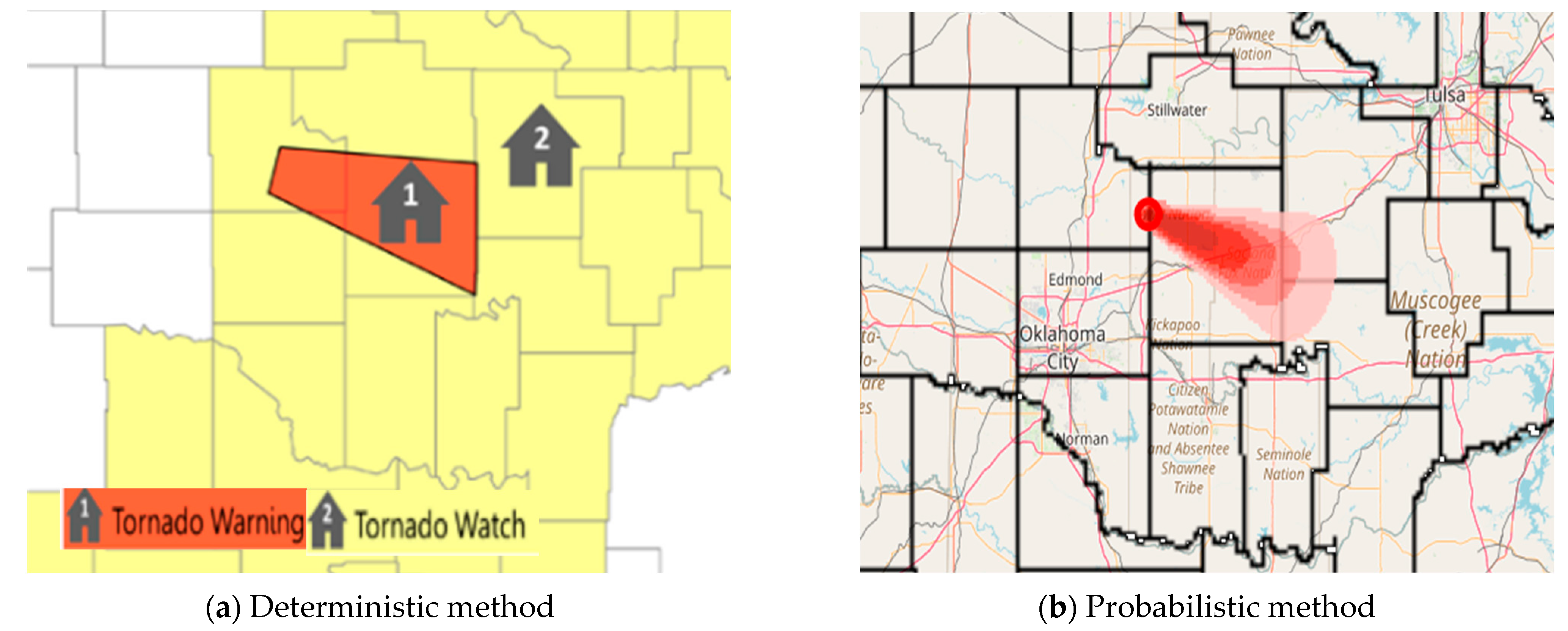

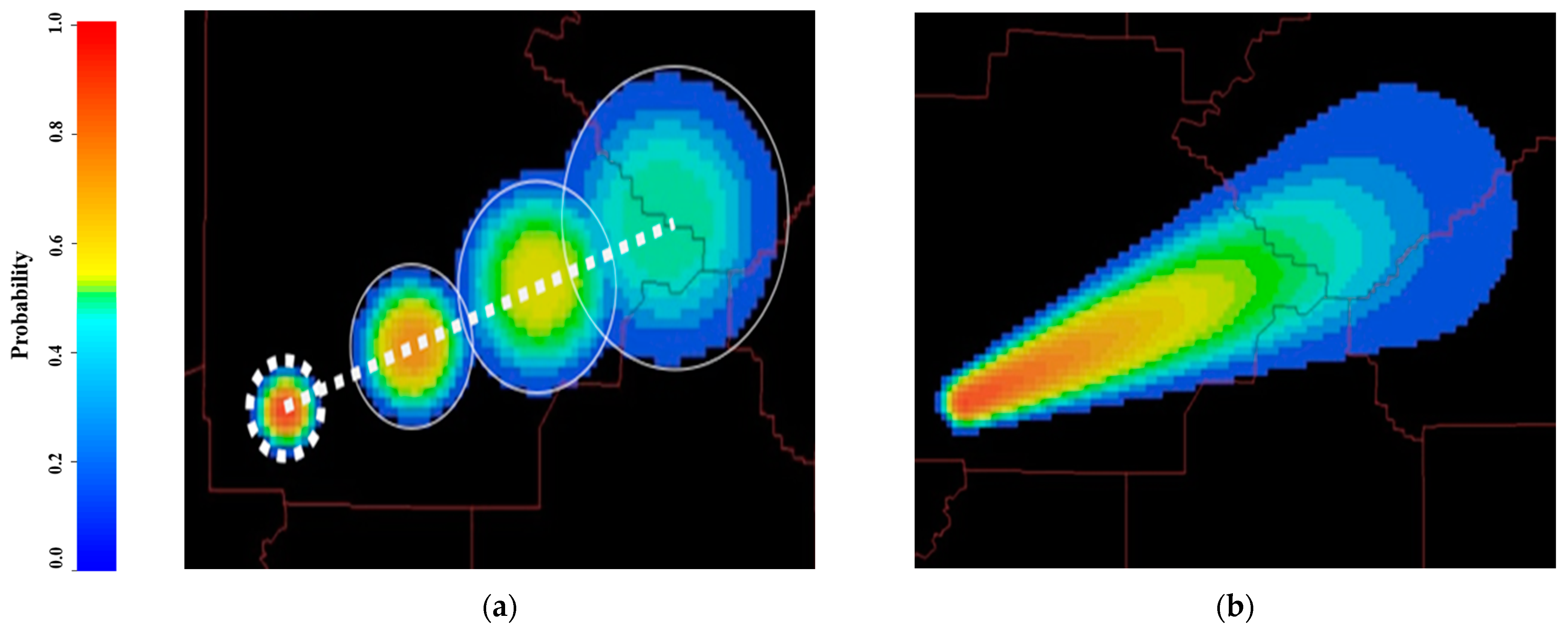
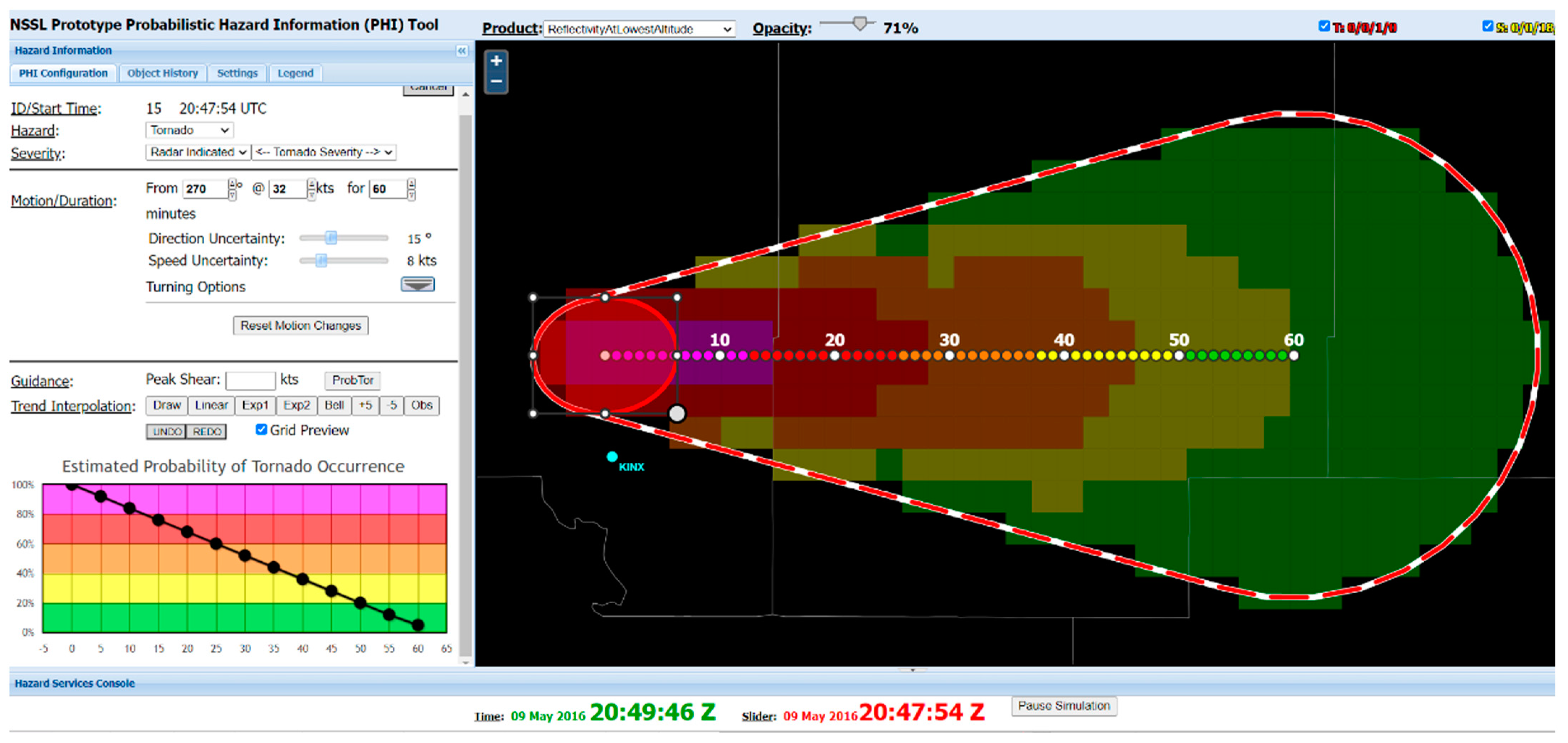
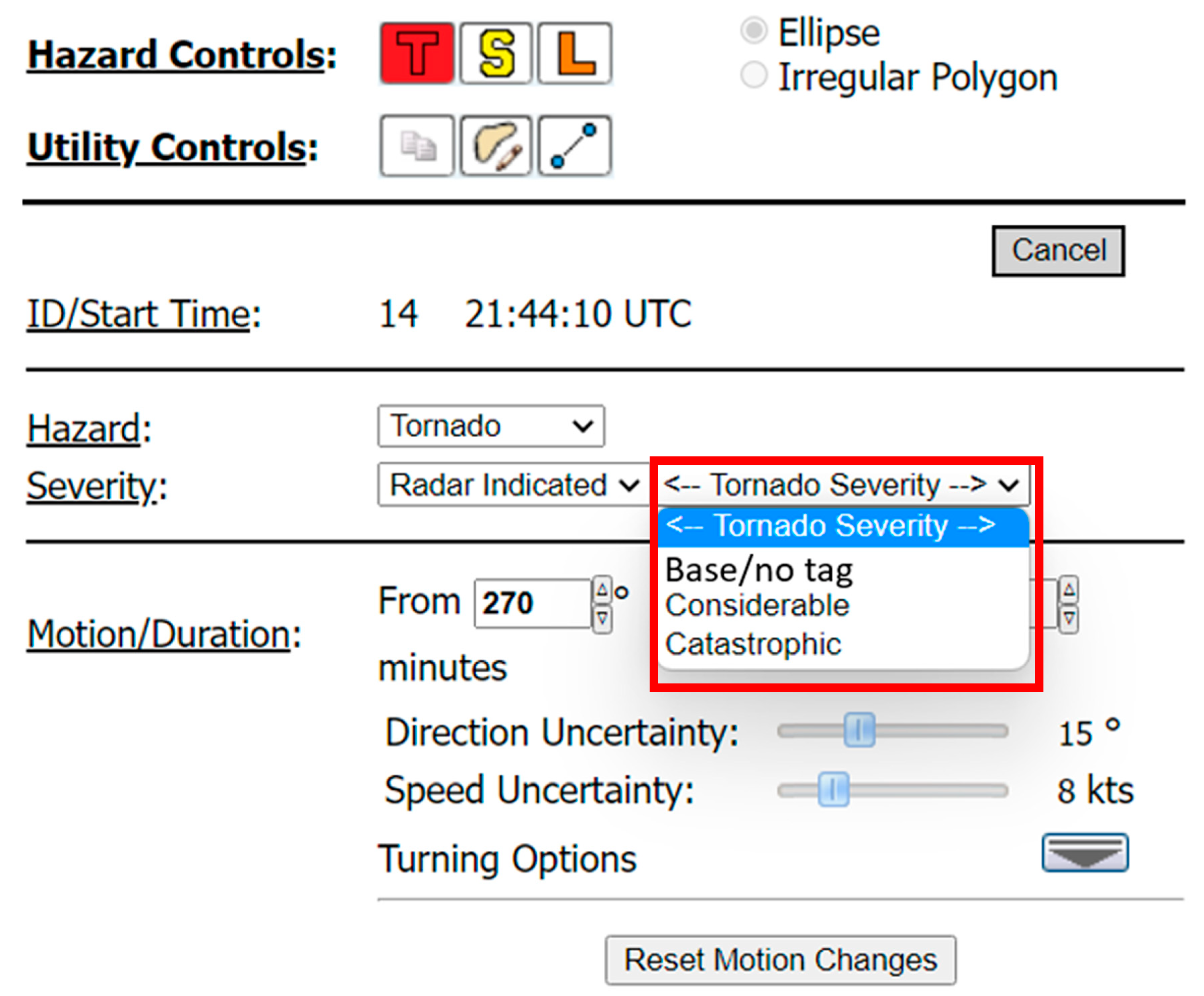

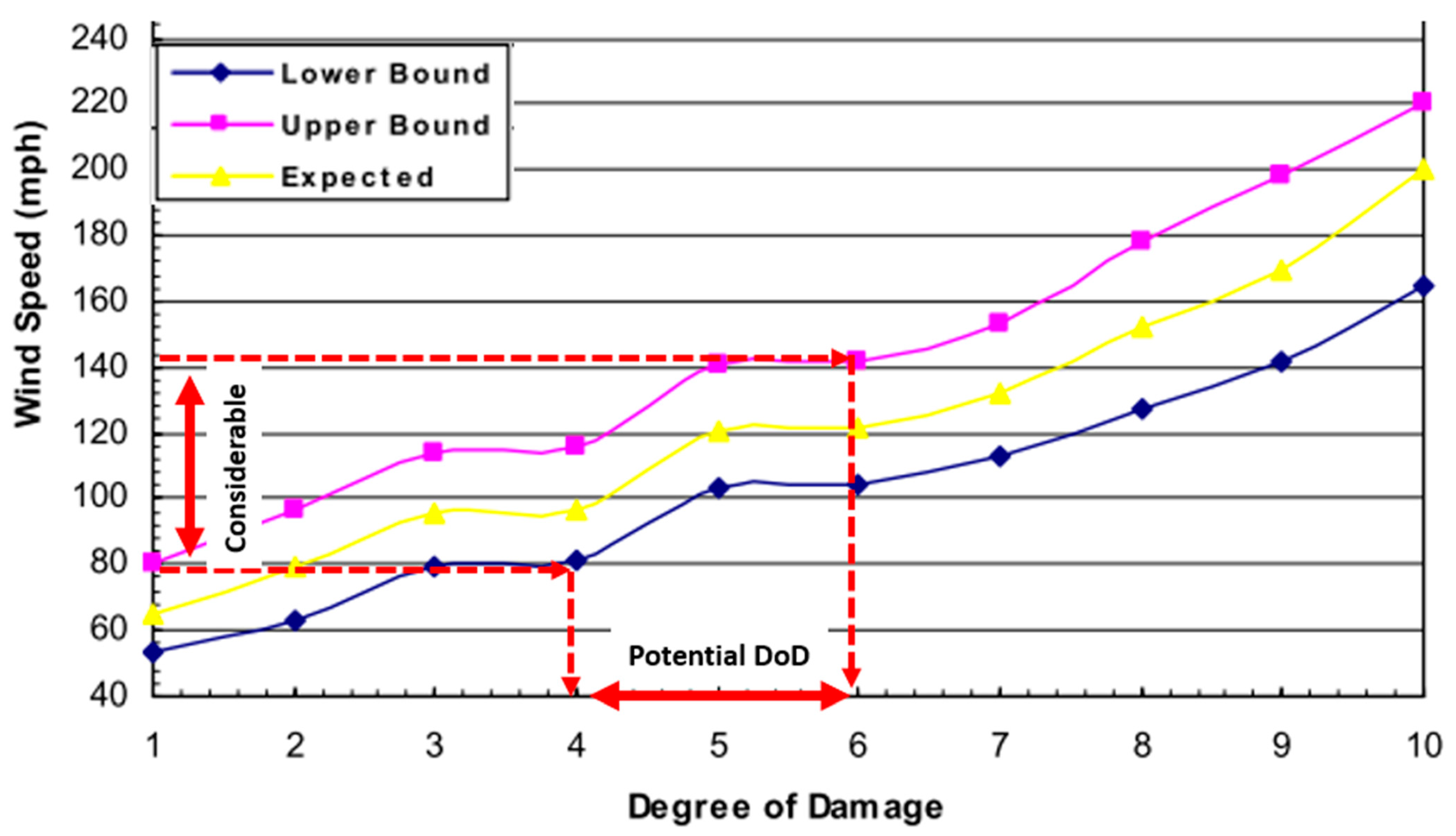

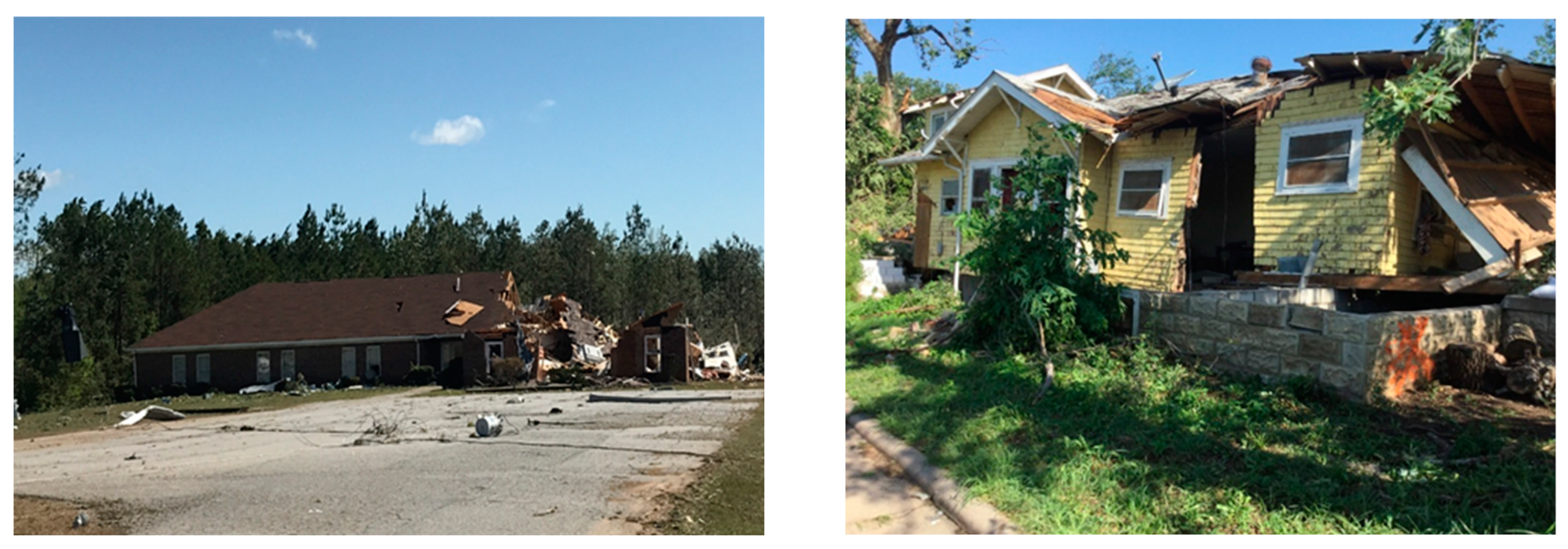
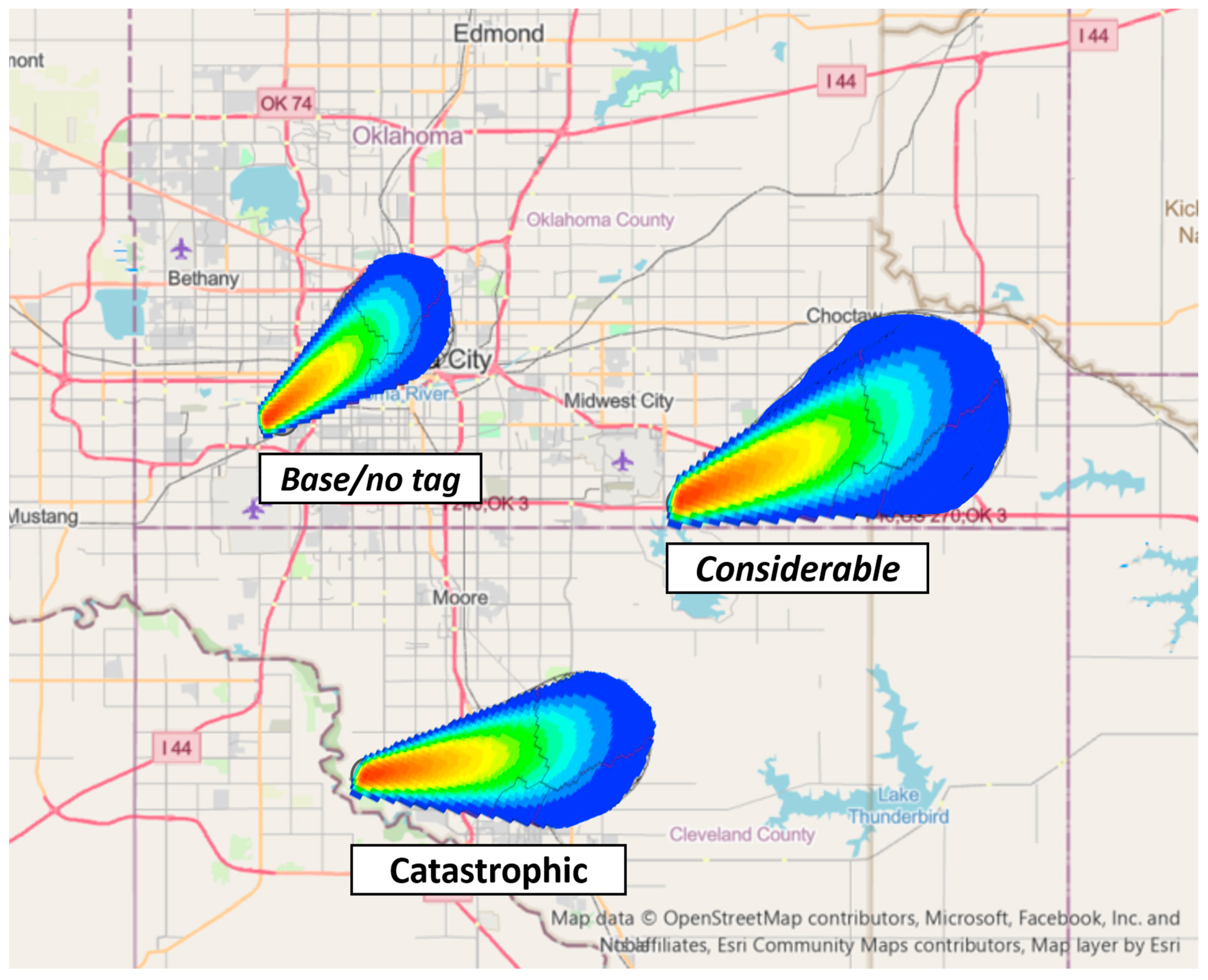
 ; (b). Hospital (10 affected)
; (b). Hospital (10 affected)  ; (c). Police station (8 affected)
; (c). Police station (8 affected)  ; (d). School (29 affected)
; (d). School (29 affected)  .
.
 ; (b). Hospital (10 affected)
; (b). Hospital (10 affected)  ; (c). Police station (8 affected)
; (c). Police station (8 affected)  ; (d). School (29 affected)
; (d). School (29 affected)  .
.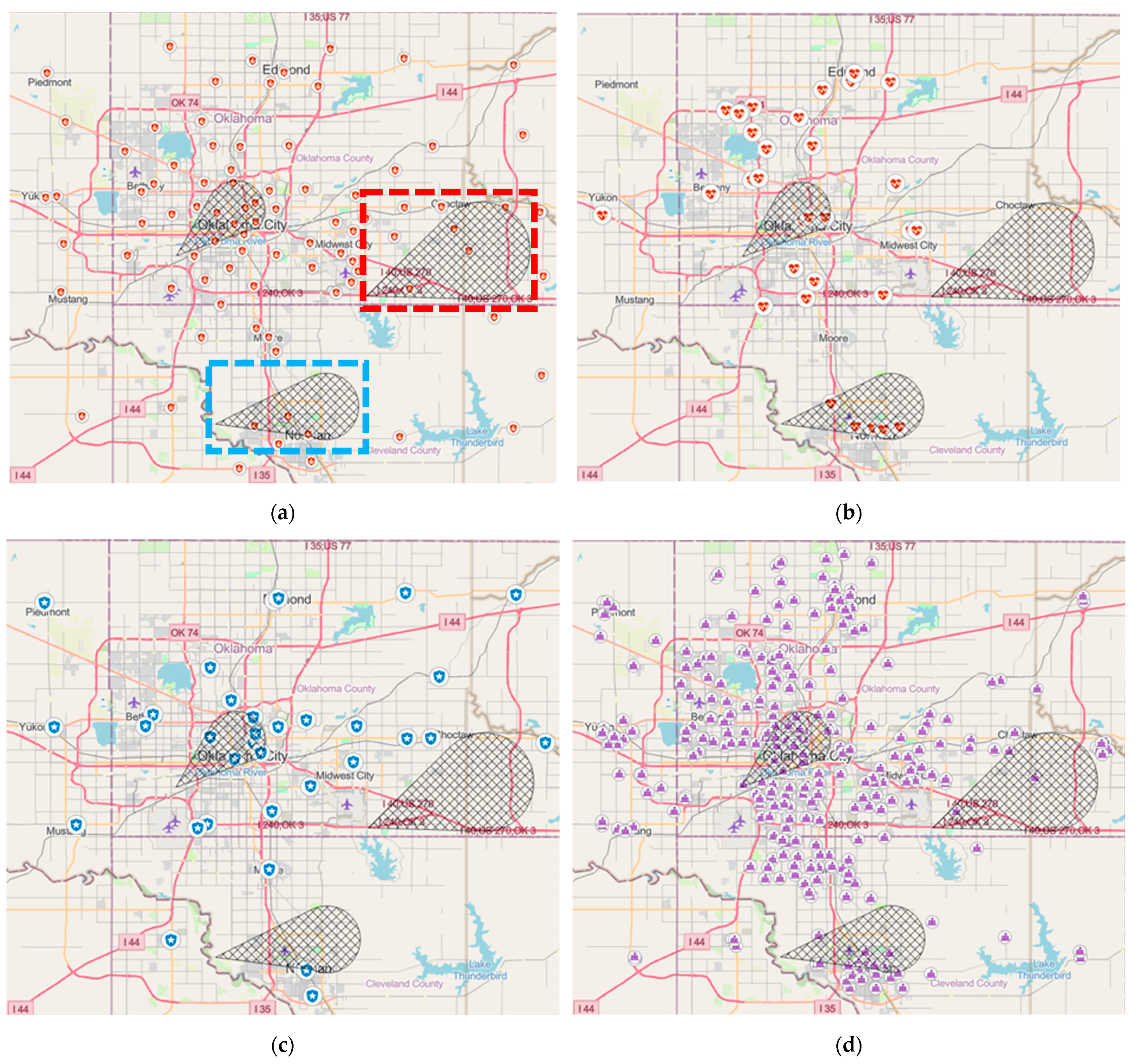
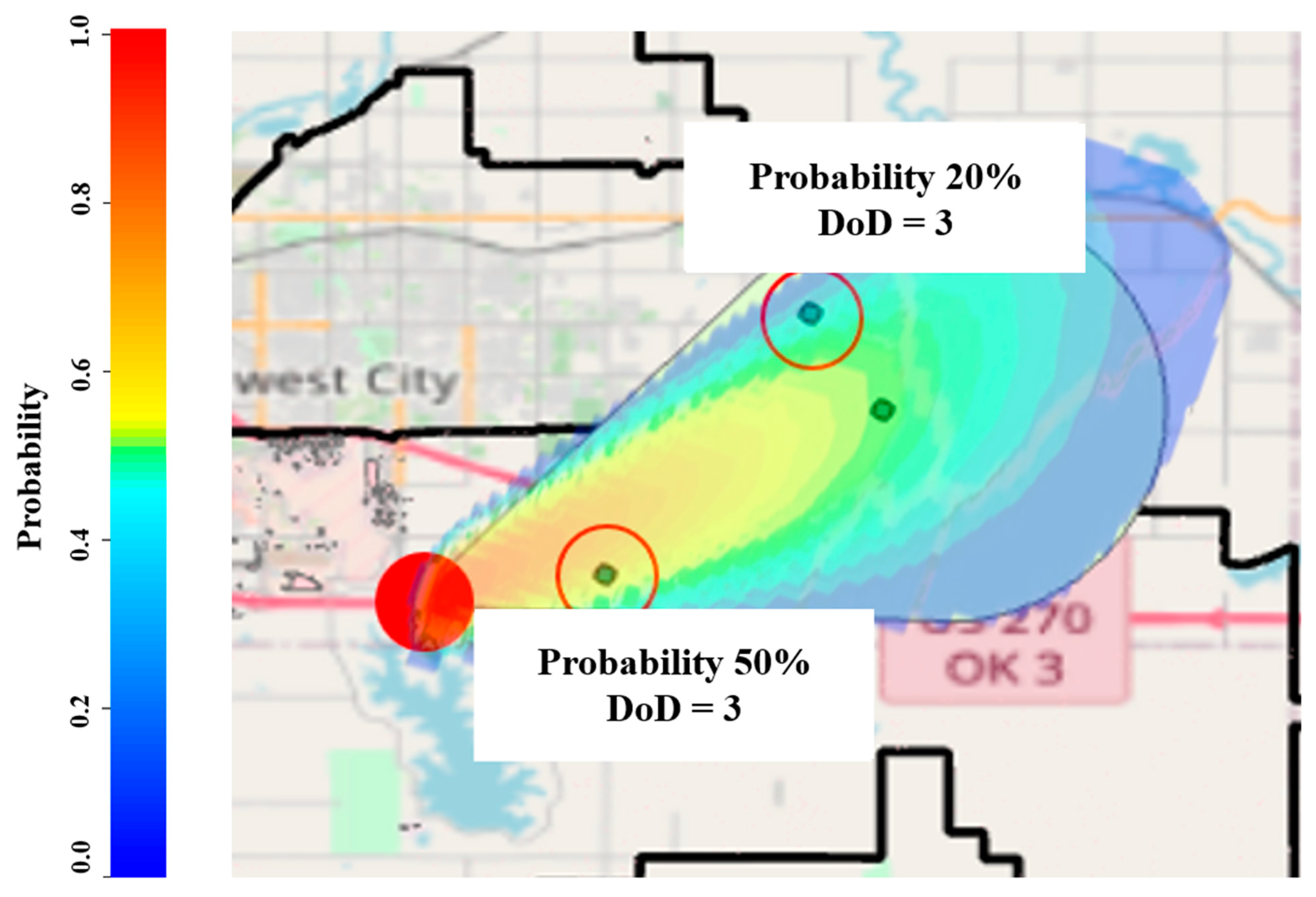
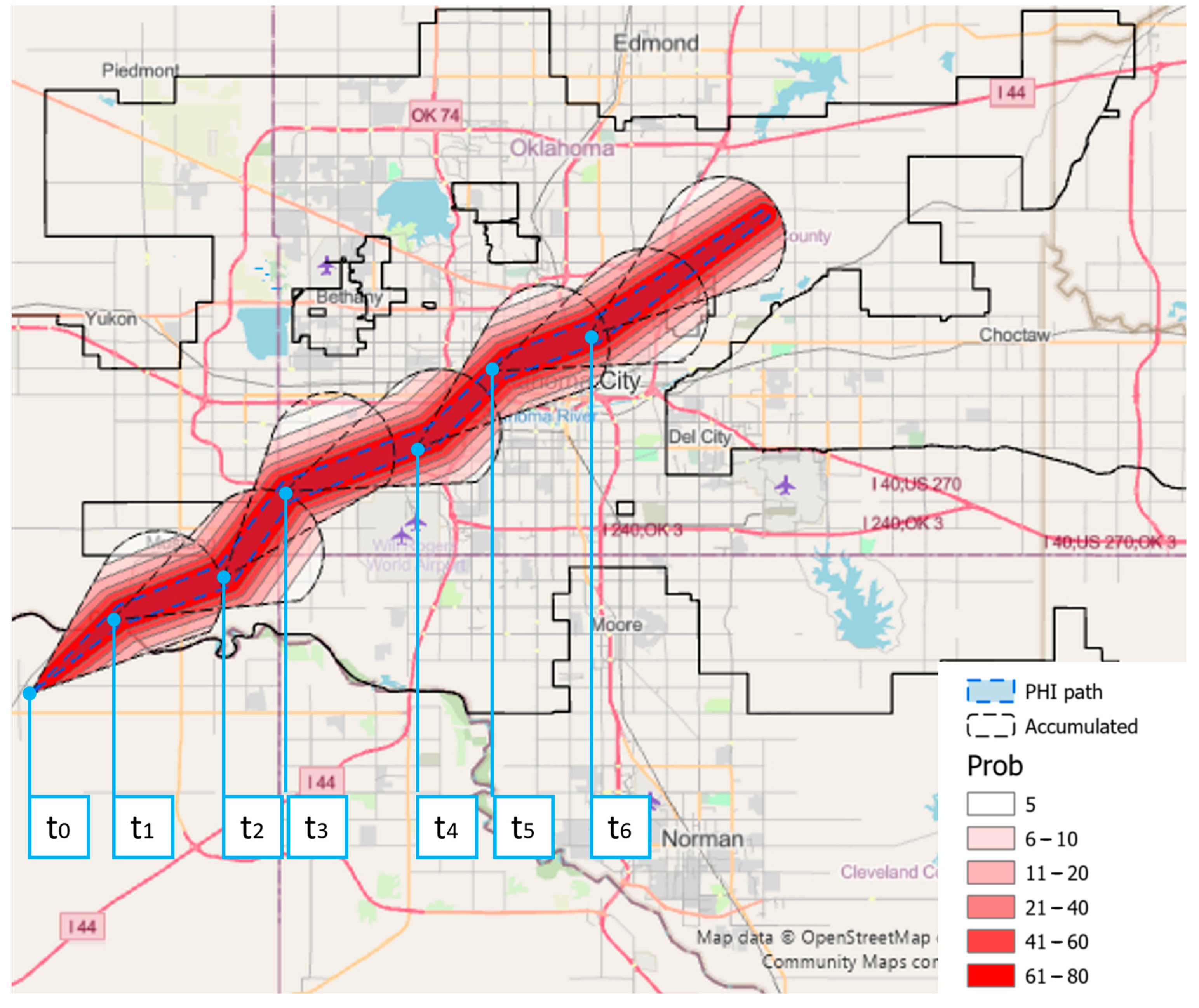
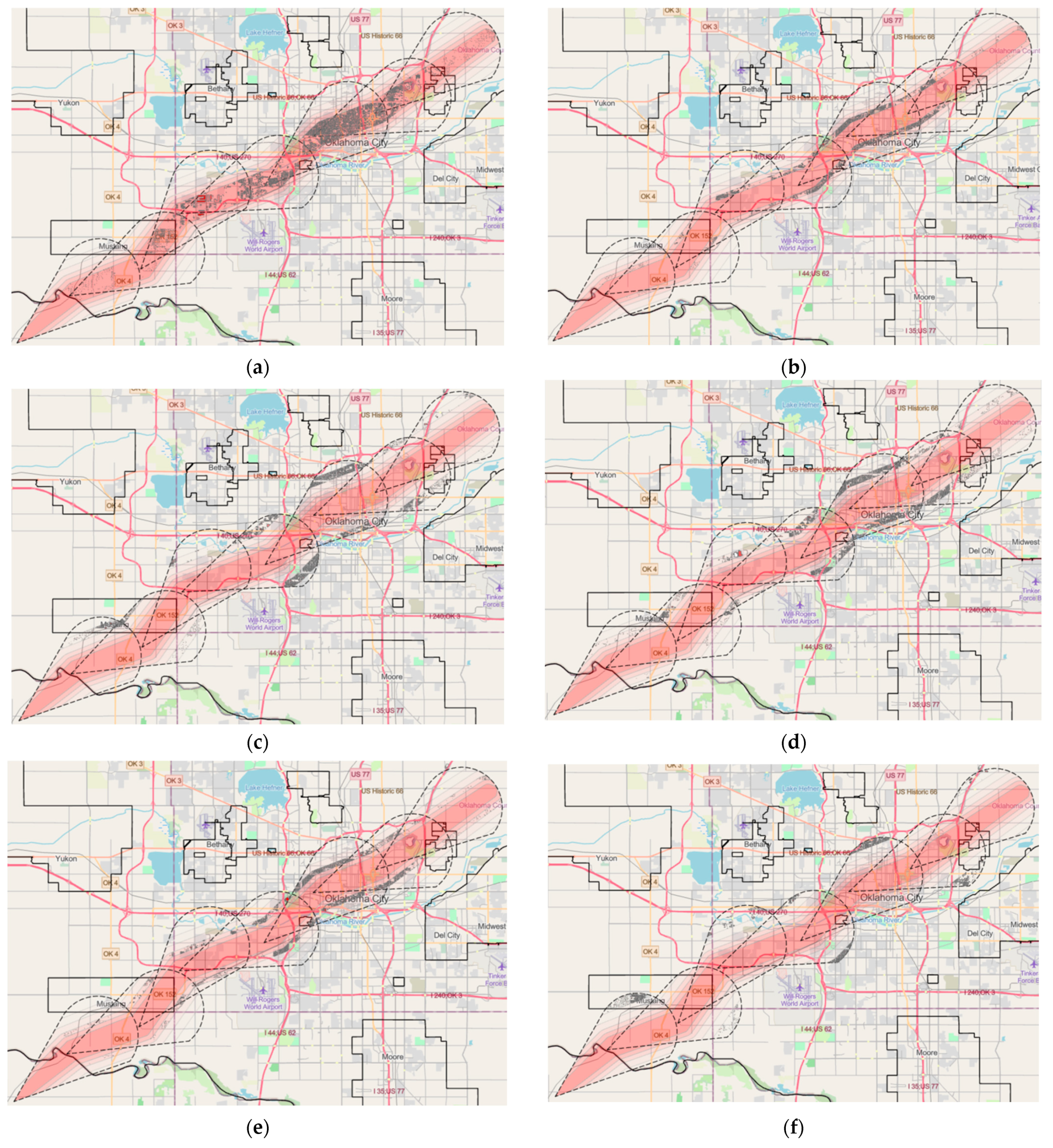
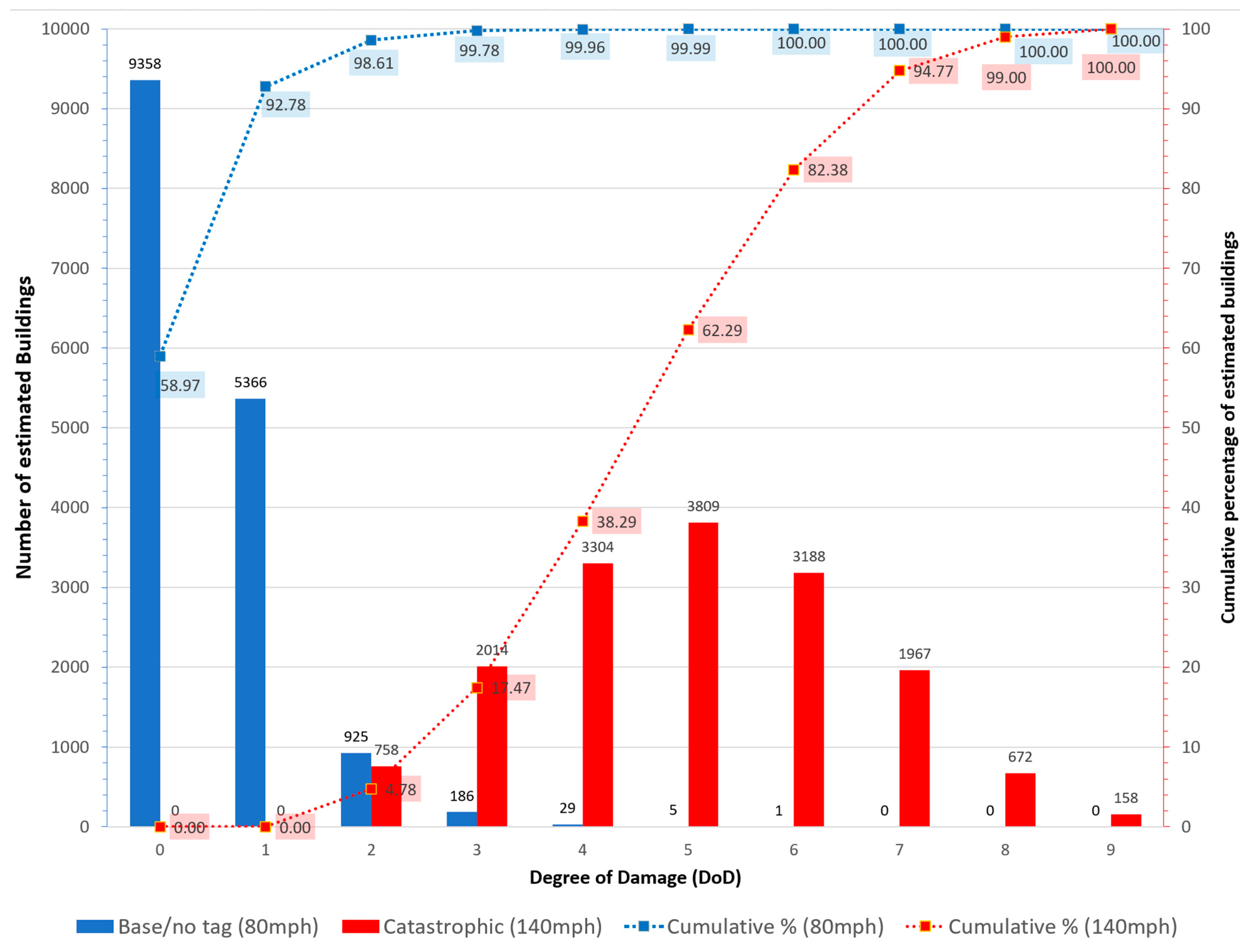
| Method | Advantages | Disadvantages |
|---|---|---|
| On-site damage survey |
|
|
| Satellite and aerial image analytics (optical images, SAR, LiDAR) |
|
|
| Unmanned aircraft data collection/analytics |
|
|
| Citizen-science based data collection and analytics |
|
|
| Field | Note | Type |
|---|---|---|
| Account number | Account number for Oklahoma County Assessor record | Identifier |
| Account type | Type of account for Oklahoma County Assessor record | Categorical |
| Area | Area of building polygon in square meters | Numeric |
| Building Number | Numeric identifier for the building (in case parcel has multiple buildings) | Numeric |
| Construction Type | Type of building construction | Categorical |
| Damage Indicator | Damage indicator number from EF scale documentation | Categorical |
| Exterior Type | Type of exterior material for building | Categorical |
| Feature ID | Unique identifier for each building polygon | Identifier |
| Foundation Type | Type of foundation for building | Categorical |
| Number of Stories | Number of stories for building | Numeric |
| Number of Vertices | Number of vertices in building polygon | Numeric |
| Parcel Number | Real Estate parcel ID number | Identifier |
| Parcel Type | Type of parcel | Categorical |
| Perimeter | Perimeter of building polygon in meters | Numeric |
| Physical Address | Physical address for parcel of land | Identifier |
| Roof Type/covering | Type of roof construction and covering materials | Categorical |
| Year | Construction year | Numeric |
| Zoning Ordinance | City zoning code for parcel where building polygon is located | Categorical |
| DI No. | Damage Indicator (DI) |
|---|---|
| 1 | Small Barns or Farm Outbuildings (SBO) |
| 2 | One- or Two-Family Residences (FR12) |
| 3 | Manufactured Home—Single Wide (MHSW) |
| 4 | Manufactured Home—Double Wide (MHDW) |
| 5 | Apartments, Condos, Townhouses [3 stories or less] (ACT) |
| 6 | Motel (M) |
| 7 | Masonry Apartment or Motel Building (MAM) |
| 8 | Small Retail Building [Fast Food Restaurants] (SRB) |
| 9 | Small Professional Building [Doctor’s Office, Branch Banks] (SPB) |
| 10 | Strip Mall (SM) |
| 11 | Large Shopping Mall (LSM) |
| 12 | Large, Isolated Retail Building [K-Mart, Wal-Mart] (LIRB) |
| 13 | Automobile Showroom (ASR) |
| 14 | Automobile Service Building (ASB) |
| 15 | Elementary School [Single Story; Interior or Exterior Hallways] (ES) |
| 16 | Junior or Senior High School (JHSH) |
| 17 | Low-Rise Building [1–4 Stories] (LRB) |
| 18 | Mid-Rise Building [5–20 Stories] (MRB) |
| 19 | High-Rise Building [More than 20 Stories] (HRB) |
| 20 | Institutional Building [Hospital, Government or University Building] (IB) |
| 21 | Metal Building System (MBS) |
| 22 | Service Station Canopy (SSC) |
| 23 | Warehouse Building [Tilt-up Walls or Heavy-Timber Construction] (WHB) |
| 24 | Electrical Transmission Lines (ETL) |
| 25 | Free-Standing Towers (FST) |
| 26 | Free-Standing Light Poles, Luminary Poles, Flag Poles (FSP) |
| 27 | Trees: Hardwood (TH) |
| 28 | Trees: Softwood (TS) |
| Impact Tag | Vrot (kt) | Wind Speed Range (mph) |
|---|---|---|
| Base/no tag | <40 | 60–110 |
| Considerable | 40–70 | 75–145 |
| Catastrophic | >70 | 100–205 |
| Critical Infrastructure Type | Impact-Tag | Potential DoD (Min–Max) |
|---|---|---|
| Fire station/Hospital/Police station(DI-20) | Base/no tag | 1–3 |
| Considerable | 3–7 | |
| Catastrophic | 6–11 | |
| Middle/High school(DI-16) | Base/no tag | 2–4 |
| Considerable | 4–8 | |
| Catastrophic | 7–11 | |
| Elementary School(DI-15) | Base/no tag | 2–4 |
| Considerable | 3–7 | |
| Catastrophic | 6–10 |
Disclaimer/Publisher’s Note: The statements, opinions and data contained in all publications are solely those of the individual author(s) and contributor(s) and not of MDPI and/or the editor(s). MDPI and/or the editor(s) disclaim responsibility for any injury to people or property resulting from any ideas, methods, instructions or products referred to in the content. |
© 2023 by the authors. Licensee MDPI, Basel, Switzerland. This article is an open access article distributed under the terms and conditions of the Creative Commons Attribution (CC BY) license (https://creativecommons.org/licenses/by/4.0/).
Share and Cite
Kim, J.; Campbell, P.A.; Calhoun, K. A Framework to Predict Community Risk from Severe Weather Threats Using Probabilistic Hazard Information (PHI). Atmosphere 2023, 14, 767. https://doi.org/10.3390/atmos14050767
Kim J, Campbell PA, Calhoun K. A Framework to Predict Community Risk from Severe Weather Threats Using Probabilistic Hazard Information (PHI). Atmosphere. 2023; 14(5):767. https://doi.org/10.3390/atmos14050767
Chicago/Turabian StyleKim, Jooho, Patrick A. Campbell, and Kristin Calhoun. 2023. "A Framework to Predict Community Risk from Severe Weather Threats Using Probabilistic Hazard Information (PHI)" Atmosphere 14, no. 5: 767. https://doi.org/10.3390/atmos14050767
APA StyleKim, J., Campbell, P. A., & Calhoun, K. (2023). A Framework to Predict Community Risk from Severe Weather Threats Using Probabilistic Hazard Information (PHI). Atmosphere, 14(5), 767. https://doi.org/10.3390/atmos14050767





